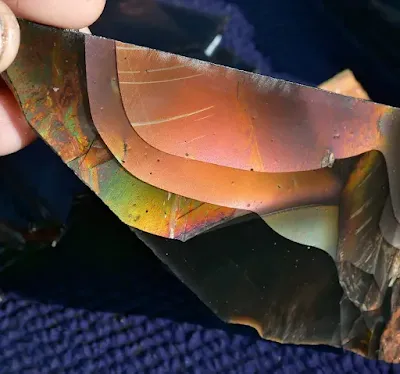Fire Obsidian: The Rarest Type of Obsidian
Fire Obsidian: The Rarest and Most Expensive Type of Obsidian
Fire obsidian is a rare variety of iridescent obsidian that is found in southeast Oregon. It is characterized by its vibrant colors and patterns, which are caused by the presence of thin layers of magnetite within the glass. The colors of fire obsidian can vary widely, but they often include red, orange, yellow, green, and blue. The patterns can be concentric circles, bands, or other geometric shapes.
Fire obsidian is formed when lava cools very rapidly, preventing the formation of crystals. This results in a glassy material that is highly reflective. The magnetite layers within the fire obsidian cause light to be reflected in different ways, creating the iridescent colors and patterns.
Where to Find Fire Obsidian
Fire obsidian is found in only one location in the world, in the Steens Mountain Wilderness in southeast Oregon. The obsidian was formed about 4-5 million years ago when a rhyolite dome erupted. The dome collapsed, leaving behind a series of dikes and flows of obsidian. The fire obsidian is found in these dikes, which are typically only a few centimeters thick.
 |
| Natural Fire Obsidian from Oregon |
Facts About Fire Obsidian
The name "fire obsidian" is derived from the way the colors of the stone appear to dance and flicker like flames.
Fire obsidian is often referred to as "iridescent obsidian."
The magnetite layers are typically only a few microns thick, which is about four times thinner than a human hair.
Fire obsidian is a relatively rare stone, and it can be quite expensive. However, its beauty and rarity make it a prized possession for many people.
Properties of Fire Obsidian
Composition: While technically still volcanic glass, fire obsidian differs from regular obsidian in having thin layers of magnetite within its structure. Its main chemical composition is still:
- SiO₂ (70-75%) - Silicon dioxide
- FeO (10-14%) - Iron oxide (responsible for magnetite formation)
- MgO (3-5%) - Magnesium oxide
- Na₂O (1-2%) - Sodium oxide
- K₂O (0.5-1%) - Potassium oxide
Color: This is where fire obsidian's magic lies. The magnetite layers interact with light, producing vibrant iridescence and shimmering patterns with various hues like red, orange, yellow, green, and blue.
Luster: Glassy, similar to regular obsidian.
Streak: Black, like regular obsidian.
Hardness: 5-6 on the Mohs scale, same as regular obsidian.
Cleavage: None, like regular obsidian.
Density: 2.5-2.6 g/cm³, slightly higher than regular obsidian due to the iron content.
Transparency: Translucent to opaque, like regular obsidian.
Fracture: Conchoidal, similar to regular obsidian, breaking with smooth, curved surfaces.
Specific Gravity: 2.5-2.6, slightly higher than regular obsidian due to the denser magnetite layers.
Solubility: Insoluble in water and common acids.
Magnetism: Weakly magnetic due to the presence of magnetite.
Fluorescence: Can exhibit bright iridescence and play of color under intense light or sunlight.
Pleochroism: Weak, with slight changes in color intensity depending on the viewing angle.
Inclusions: The key component of fire obsidian is the presence of thin layers of magnetite, responsible for the iridescent colors and patterns.
Iridescence: Caused by thin layers of magnetite within the obsidian
 |
| Natural rough fire obsidian from Oregon. This is how fire obsidian looks before it is polished and cut. Photo by: David Lineberger |
Fire obsidian is a very rare gemstone, and it is only found in one location in the world. As a result, it is highly prized by collectors and jewelry makers. It is also used in some traditional cultures for ceremonial purposes.
Fire Obsidian Uses
Jewelry and ornamentation:
Eye-catching cabochons: Fire obsidian's vibrant swirls and flashes of color make it perfect for transforming into stunning cabochons for rings, pendants, and bracelets. Imagine a ring boasting a miniature sunset within its depths!
Sculptures and carvings: Skilled artisans can sculpt fire obsidian into breathtaking sculptures or intricate carvings, letting the stone's natural patterns guide their hands. Picture a shimmering firebird taking flight from a polished obsidian base.
Metaphysical and spiritual uses:
Protective stone: Traditionally believed to shield against negativity and harmful energies, fire obsidian's fiery iridescence is seen as a powerful ward. Imagine carrying a pocket-sized shield of shimmering hues.
Stone of transformation: Associated with inner change and personal growth, fire obsidian's ever-shifting colors are thought to symbolize the transformative journey. Visualize your life's path reflected in the gemstone's unpredictable dance of light.
Decorative applications:
Mosaic tiles: Imagine a mosaic wall or tabletop where each fire obsidian tile becomes a miniature kaleidoscope, adding a touch of mesmerizing magic to any space.
Functional art: Fire obsidian can be incorporated into functional objects like paperweights, bookends, or even lamp bases, turning everyday items into mesmerizing conversation starters.
Fire obsidian is more than just a pretty rock. Its story of formation, its captivating beauty, and its diverse uses make it a truly fascinating gemstone. So, the next time you encounter this dazzling wonder, remember the fire that dances within its depths and let its magic spark your imagination.
 |
| Fire Obsidian cabochon from Lake County, Oregon. Photo by J. Scovil |
Is Fire Obsidian a Natural or Treated Stone?
Fire obsidian is generally considered a natural stone. The play of colors is believed to be a natural characteristic resulting from the unique conditions under which the obsidian formed. However, like other gemstones, it's always a good idea to ask about any treatments or enhancements.
See also:
Obsidian: Volcanic Glass
Rainbow Obsidian
Snowflake obsidian
What is Green Obsidian
Velvet Obsidian: Volcanic, Shimmering Delight


%20(1).webp)






